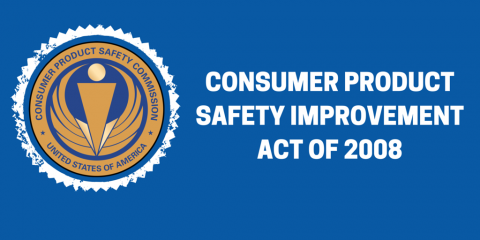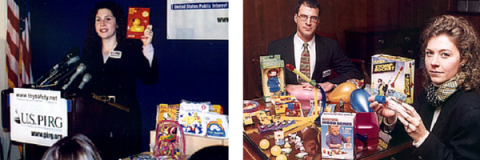
30 Years of “Trouble in Toyland”, 30 Years of Safety Improvements
By Anna Low-Beer
Every year, OSPIRG Foundation releases Trouble in Toyland, a report on toy safety which examines toys bought at major national retailers, looking for safety hazards including toxic toys, choking hazards, labeling violations, powerful magnets, and excessively loud toys. We continue to find these hazards on store shelves, which indicates the need for continued vigilance and adequate enforcement of safety regulations.

In 2013 (the last year for which data is available), there were 256,700 toy-related injuries treated in U.S. hospital emergency departments, and nine toy-related deaths.1 Just last year, over 2.7 million units of children’s toys were recalled. But despite lingering dangers, in the last 30 years we’ve come a long way in terms of both policy and compliance with standards.
Here are some of the major milestones in the past 30 years:
The Child Safety Protection Act
From 1980-1992, the Consumer Product Safety Commission (CPSC) and Congress did little to protect children from dangerous products. Throughout the 1980s and early 1990s, PIRG and other consumer groups lobbied Congress and the CPSC to increase the size of the small parts choking hazard test and to require appropriate choke hazard warning lablels. A 1992 campaign led by ConnPIRG and a number of child safety advocates resulted in a firm choke hazard warning label law that took effect in Connecticut in 1993. The Connecticut law laid the groundwork for a federal standard.
In 1994, after years of battling the influential toy lobby, Congress finally passed PIRG’s child safety proposal, the Child Safety Protection Act (CSPA), which took effect in January 1995. The legislation was monumental — for the first time, explicit choke hazard warning labels were required on all toys containing small parts intended for children aged three to six, and the same warnings were required on balloons, small balls, and marbles. It also increased the size of banned small balls, as round objects are especially dangerous choking hazards. This legislation was a powerful first step towards safer toys.
The Consumer Product Safety Improvement Act
In 2008, after a series of record-breaking toy recalls—with millions of units of lead-laden brand name iconic toys such as Thomas the Tank Engine, Congress passed the Consumer Product Safety Improvement Act (CPSIA), which gave the CPSC the power to rush recalls, hold toy manufacturers more accountable, and ban specific toxic chemicals in children’s products.2

Key provisions of the CPSIA substantially reduced allowable limits on toxic substances, including lead, in toys and other children’s products. Even low levels of lead in the blood have been proven to negatively affect IQ, attentiveness, and overall development; in fact, the Center for Disease Control and Prevention has made it clear that any amount of lead in a child’s blood is unsafe.3 Lead is used in paint and protective coatings, batteries, plastics, and radiation shielding, and can sneak into toys especially easily if they are made abroad and imported.3
The CPSIA requires that children’s products manufactured after August 2011 contain no more than 100 parts per million (ppm) of total lead content.4 Though this standard could be even more protective, overall the CPSIA has led to increased protection and vigilance against lead levels in children’s products, among other things.
Since 2008 and the passing of the CPSIA, the number of children’s products recalled on a yearly basis has continued to decline — whereas before the law, recalls were increasing.5 This data shows that the CPSIA has had a role in reversing a dangerous trend.
Stronger standards for phthalates
Phthalates are a group of chemicals often used to soften and increase flexibility in plastics, and they are used in an incredible range of products, from flooring and clothing to toys. Phthalates have the potential to interfere with crucial stages of growth, including puberty and the development of the male reproductive system, and at least one type of phthalate is suspected of causing cancer.6Children are especially vulnerable to these negative effects, and are also generally exposed to a higher level of phthalates because they often explore the world by putting toys and other objects in their mouths.7
In 2008, the CPSIA permanently banned three types of phthalates (DEHP, DBP, and BBP) at levels greater than 1,000 ppm in the plastic parts of children’s products, and also placed an interim ban on three other types of phthalates (DINP, DIDP, and DnOP) in parts of children’s products that can be placed in a child’s mouth.8 The interim ban is in place while the CPSC studies these additional phthalates. In 2014, the CPSC proposed a rule to permanently prohibit children’s products that contain over 1,000 ppm of a longer list of phthalates (DINP, DIBP, DPENP, DHEXP, and DCHP), but that rule has not yet been finalized.9
Our research and findings on phthalates emphasize the need to continuously study chemicals in our everyday products for possible health hazards, because we’ve known about the dangers of lead for decades, but many chemical threats like phthalates are relatively new. Still, the CPSC’s proposed 2014 rule shows increased research on and awareness of the dangers of toxic chemicals in toys.
Ban on small, powerful magnets
Small, powerful magnets have become increasingly popular in the 21st century — but they have the potential to cause serious injury and even death due to complications arising from ingestion. Swallowing two or more can result in attractive forces pulling them together inside the body, causing obstructions or pinching, or trapping intestinal walls or other digestive tissue. In the worst cases, once ingested, these magnets can even perforate intestinal walls. The ingestion of magnets often leads to invasive medical intervention, either with an endoscopy, surgery, or both.
Small magnets are found in construction sets, puzzles, toy jewelry, action figures, board games, and train sets, and are also used in products geared towards adults like desk toys and stress relievers. The BB pellet-sized magnet sets called “Buckyballs” are perhaps the most well-known example of the dangers tiny, powerful magnets pose. Numerous incidents reported to the CPSC make it clear that children can swallow these magnets and suffer serious injuries – highlighting the need for appropriate warning labels on adult novelty items that might be hazardous to children.10 Between 2009 and 2013, the CPSC estimates that high-powered magnets led to approximately 2,900 emergency room-treated injuries.11

In 2012, the CPSC sued several manufacturers to stop the distribution of Buckyballs and similar products, arguing that the labels were ineffective in preventing injuries. All but one of the manufacturers settled with the CPSC by the summer of 2014 and recalled their products. Then in 2014, the CPSC issued a new rule establishing htat all powerful magnets must be too large to fit into the official small parts cylinder used by the CPSC to determine choke hazards. The separate ASTM F963 standard for toys bans loose magnets or magnetic components in toys for children under 14 (with certain exceptions).
Overall, the bans of small powerful magnets in the last decade are representative of great toy safety progress.
The road to safer toys
In the past thirty years, the Trouble in Toyland report has led to over 150 recalls and various regulatory actions. Our advocacy has also demonstrated the benefits of the PIRG state and federal model. In 1992, following years of unsuccessful pressure on the CPSC and Congress to add warning labels to toys for older children that contain small part choking hazards banned for children under three years old, we turned our attention to the states and launched numerous campaigns. Connecticut’s law passed first and the toy manufacturers immediately sued. Then-state Attorney General Richard Blumenthal (now a U.S. Senator) successfully defended the ConnPIRG-backed law. This forced the toy industry to the negotiating table and resulted in the passage of the 1994 Child Safety Protection Act, which established express small parts warning labels and subjected small balls to a stricter choking test than other small toy parts, since round objects can more easily block airways.

Going forward, we are pleased with the progress we have made and will continue to advocate for improving choking hazard rules and banning more toxic chemicals. We will also fight against general attacks on consumer protection regulations that affect the CPSC and other agencies. Dangers are still present, and parents and regulators must remain vigilant, but there are many signs of progress toward safer toys and children’s products. From legislation like the Consumer Product Safety Improvement Act to recent phthalate and magnet bans, 30 years of Trouble in Toyland have made our kids safer.
1Consumer Product Safety Commission, Toy Injuries Statistics, Accessed 11/16/2015.
2Kirschman, K.B. & Smith, G.A. (2007), Resale of recalled children’s products online: an examination of the world’s largest yard sale, 2007.
3Center for Disease Control and Prevention, Lead: Prevention Tips, Accessed 11/12/2015.
4The Consumer Product Safety Commission, Total Lead Content, Accessed 11/16/2015.
5Kids in Danger, A Decade of Data: An In-depth Look at 2014 and a Ten-Year Retrospective on Children’s Product Recalls, 2015.
6National Institutes of Health, National Library of Medicine, Phthalates, Accessed on 11/16/2015.
7Center for Disease Control and Prevention, Phthalates, Accessed on 11/16/2015.
8Consumer Product Safety Commission, Phthalates,” Accessed 11/16/2015.
9Consumer Product Safety Commission, Prohibition of Children’s Toys and Child Care Articles Containing Specified Phthalates, Accessed 11/16/2015.
10Consumer Product Safety Commission, CPSC Warns High-Powered Magnets and Children Make a Deadly Mix, Accessed 11/16/2015.
11Consumer Product Safety Commission, Magnets Information Center, Accessed 11/16/2015.
Topics
Find Out More


A look back at what our unique network accomplished in 2023

Mastercard, don’t sell my data
